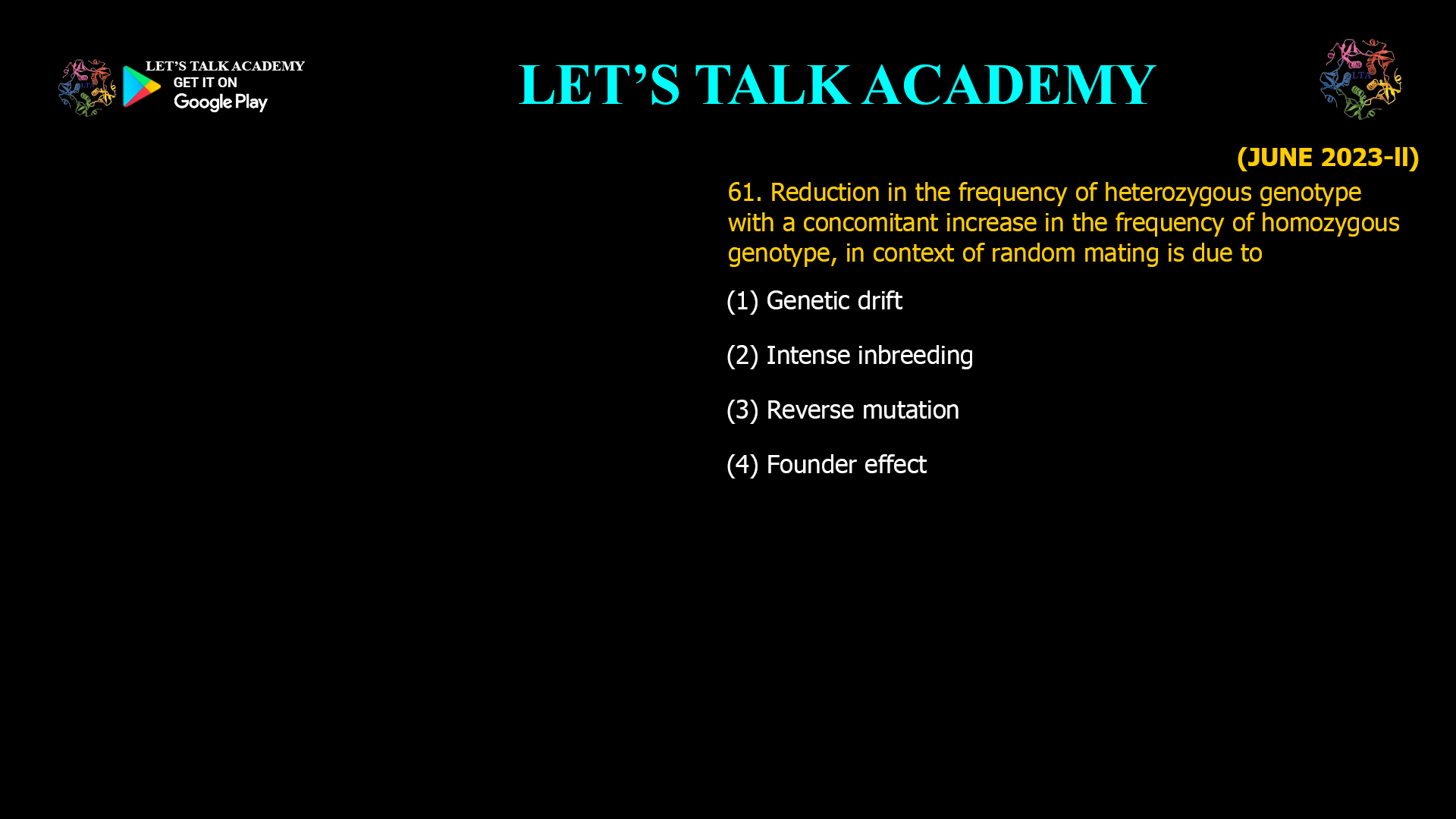- Reduction in the frequency of heterozygous genotype with a concomitant increase in the frequency of homozygous genotype, in context of random mating is due to
(1) Genetic drift (2) Intense inbreeding
(3) Reverse mutation (4) Founder effectWhat is Genetic Drift?
Genetic drift refers to the random fluctuations in allele frequencies within a population from one generation to the next. Unlike natural selection, which is driven by differential survival and reproduction based on fitness, genetic drift is a stochastic process—meaning it is governed by chance events rather than adaptive advantage. This randomness can cause certain alleles to become more common or disappear entirely, regardless of their impact on survival or reproduction.
How Genetic Drift Affects Genotype Frequencies
In a large, randomly mating population, allele and genotype frequencies tend to remain stable over generations, provided that evolutionary forces such as selection, mutation, and migration are absent. This stability is described by the Hardy-Weinberg equilibrium. However, when populations are small, genetic drift becomes a significant force, leading to:
-
Reduction in heterozygosity: The frequency of heterozygous individuals (those with two different alleles at a locus) decreases over time.
-
Increase in homozygosity: The frequency of homozygous individuals (those with two identical alleles at a locus) increases correspondingly.
This shift occurs because, in each generation, the random sampling of alleles can result in the loss of some alleles and the fixation of others, reducing the overall genetic diversity.
Mechanisms Behind the Reduction in Heterozygosity
The effect of genetic drift on genotype frequencies is particularly pronounced in small populations. Here’s how it works:
-
Random Sampling: In small populations, the alleles that are passed on to the next generation are a random sample of those present in the current generation. This sampling error can lead to certain alleles being overrepresented or lost entirely.
-
Loss of Heterozygosity: As alleles are lost, the proportion of individuals who are heterozygous (carrying two different alleles) decreases. Mathematically, the per-generation loss of heterozygosity due to genetic drift can be estimated as Δh=−12N, where N is the population size.
-
Fixation of Alleles: Over time, one allele may become fixed (reach a frequency of 1), while others are lost (frequency drops to 0). At fixation, all individuals are homozygous for the fixed allele.
Examples: Founder Effect and Bottleneck Effect
Two classic scenarios illustrate how genetic drift reduces heterozygosity:
-
Founder Effect: When a small group of individuals establishes a new population, the genetic makeup of this new group may not represent the diversity of the original population. The limited gene pool can lead to rapid increases in homozygosity and loss of heterozygosity.
-
Bottleneck Effect: When a population undergoes a drastic reduction in size due to a catastrophic event, the surviving individuals represent only a fraction of the original genetic diversity. As the population recovers, it does so from this reduced gene pool, leading to increased homozygosity and decreased heterozygosity.
Both effects are forms of genetic drift and are especially impactful in small populations.
Genetic Drift vs. Other Evolutionary Forces
To clarify, let’s compare genetic drift to other processes that can alter genotype frequencies:
Evolutionary Force Effect on Heterozygosity Mechanism Genetic Drift Decreases Random sampling in small populations Inbreeding Decreases Mating between relatives increases homozygosity, but does not change allele frequencies directly Natural Selection Variable Can increase or decrease heterozygosity depending on selection type Mutation Increases Introduces new alleles, potentially increasing heterozygosity Gene Flow Increases Migration introduces new alleles, increasing heterozygosity While inbreeding also increases homozygosity, it is a result of non-random mating, not random processes. Genetic drift, in contrast, operates even under random mating conditions, provided the population is small.
Evolutionary Consequences of Reduced Heterozygosity
The reduction in heterozygosity and increase in homozygosity have several important implications:
-
Reduced Genetic Variation: Populations become more genetically uniform, which can reduce their ability to adapt to environmental changes.
-
Increased Risk of Genetic Disorders: Homozygosity can expose deleterious recessive alleles, leading to higher incidences of genetic diseases.
-
Potential for Speciation: In isolated populations, genetic drift can lead to divergence from the original population, potentially resulting in the formation of new species over time.
Conclusion
In summary, genetic drift is the primary cause of reduced heterozygosity and increased homozygosity in randomly mating populations, especially when population size is small. This process operates independently of natural selection and can have profound effects on the genetic structure and evolutionary fate of populations. Understanding genetic drift is essential for fields ranging from evolutionary biology to conservation genetics, as it helps explain patterns of genetic diversity and the mechanisms driving evolutionary change.
-



